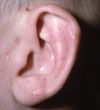- Clinical Technology
- Adult Immunization
- Hepatology
- Pediatric Immunization
- Screening
- Psychiatry
- Allergy
- Women's Health
- Cardiology
- Pediatrics
- Dermatology
- Endocrinology
- Pain Management
- Gastroenterology
- Infectious Disease
- Obesity Medicine
- Rheumatology
- Nephrology
- Neurology
- Pulmonology
Atopic Dermatitis on Ears and Atopic Dermatitis on Trunk
An extensive, highly pruritic rash; hypopigmented macules; a scaly,pruritic plantar eruption that resists antifungals--can you identify thedisorders pictured here?

Case 1:
For several weeks, an 18-year-old man has been bothered by itchy ears. He has seasonal allergies that are well controlled with oral antihistamines. He has not been exposed to contactants and has not used any nutritional supplements or new shampoos or conditioners. He works out at a gym 5 days a week.
Which of the following do you suspect?
A. Relapsing polychondritis.
B. Atopic dermatitis.
C. Seborrheic dermatitis.
D. Psoriasis.
E. Contact dermatitis.
(Answer on next page.)

Case 1: This patient had a flare of atopic dermatitis, B. A mid-potency topical corticosteroid helped relieve the symptoms. No obvious cause was identified.
Relapsing polychondritis is typically painful, not pruritic. Seborrheic dermatitis and psoriasis usually involve the external auditory canal and the area behind the ears. Contact dermatitis may be ruled out because there was no exposure history.


Case 2:
For 2 to 3 weeks, a 32-year-old woman has been troubled by a highly pruritic eruption, primarily on the trunk. She recently started exercising at a local club several times a week and has purchased some new workout clothing. She also has started to shower more frequently. She has a family history of allergies but none herself. She has not been ill recently and takes no medication other than an oral contraceptive. She has no pets.
What is your clinical impression?
A. Atopic dermatitis.
B. Contact dermatitis.
C. Pityriasis rosea.
D. Psoriasis.
E. Dermatophyte infection.
(Answer on next page.)


Case 2: This patient's underlying atopic dermatitis, A, which manifested as nummular patches of eczema, was exacerbated by her new habit of bathing twice a day. She had been using a pouf-type washcloth that caused excessive drying of the skin and consequent eruption of eczema. The eruption resolved with the application of a mid-potency corticosteroid cream, discontinuation of washcloth use, and a reduction in the number of showers.
Contact dermatitis is sometimes seen with new clothing, but the distribution of this patient's rash spared some areas where the clothing was tight. Pityriasis rosea was considered because of the oval shape of some of the lesions, but other areas did not display this characteristic appearance. Psoriasis has more scale and would appear in such classic locations as elbows, knees, and scalp. Such an extensive dermatophyte infection would be more likely in an immunocompromised person or a patient with type 1 diabetes.

Case 3:
For several weeks, a 10-year-old boy's feet have been scaly and pruritic. He plays basketball and soccer and recently bought new shoes. A trial of over-the-counter miconazole was ineffective. The patient has a history of childhood eczema but outgrew it about 5 years ago.
What might explain the boy's symptoms?
A. Contact dermatitis to new shoes.
B. Juvenile plantar dermatitis.
C. Tinea pedis.
D. Psoriasis.
E. Keratoderma.
(Answer on next page.)

Case 3: The triad of sweaty feet, occlusive footwear, and a history of eczema suggests juvenile plantar dermatitis, B. Symptoms can be controlled if patients keep their feet dry by using foot powder and changing socks frequently. Topical corticosteroids or topical immunomodulators, such as tacrolimus and pimecrolimus, are also effective. Juvenile plantar dermatitis typically improves at puberty.
Contact dermatitis to shoes usually manifests on the dorsa of the feet. Tinea pedis is usually scalier and, unlike juvenile plantar dermatitis, involves the toe webs. Psoriasis is unlikely to involve just the soles and features more erythema and scale. Keratoderma is characterized by a thickened layer that produces a waxy appearance.

Case 4:
A 10-year-old boy has noticed asymptomatic discoloration on his back this summer. He has mild seasonal allergies that are controlled with over-the-counter medications. He plays soccer and has been swimming in a pool. He has had a dog and a cat for the past 2 years.
Which of the conditions in the differential is the likely diagnosis?
A. Vitiligo.
B. Pityriasis alba.
C. Tinea versicolor.
D. Tinea corporis.
E. Pityriasis rosea.
(Answer on next page.)

Case 4: This patient has pityriasis alba, B, a postinflammatory hypopigmentation associated with chronic eczema; it interferes with normal tanning. The patient was advised to change his bathing routine (no washcloth, lukewarm water, no antibacterial soaps, avoid washing rash) and to apply a moisturizer, sunscreen, and a low-potency topical corticosteroid.His skin color evened out during the next 4 to 6 weeks.
Vitiligo consists of permanent depigmentation, not reversible hypopigmentation. Tinea versicolor, tinea corporis, and pityriasis rosea all feature scaling, and the latter two are usually pruritic.
More Dermclinic
